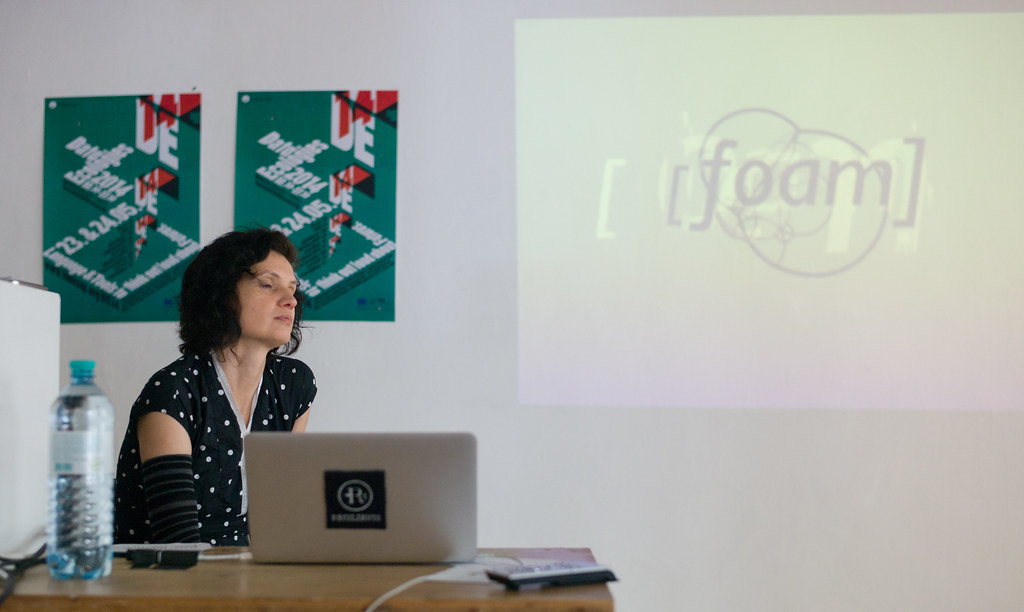Future Fabulators
Table of Contents
Data Ecologies 14 - various notes
Lecture notes from the 2014 edition of data_ecologies (as extrapolated during http://timesup.org/DE14 and http://timesup.org/DE14-booksprint)
Audio recordings of the talks can be found at → http://physicalnarration.org/DE14_AUDIO
further details and edits from the dilgent TU note takers → http://wiki.physicalnarration.org/wiki/index.php/DE14
Time's Up
(see also http://wiki.physicalnarration.org/wiki/index.php/DE14TU )
- 2003 - 5-6 data ecologies so far
- originally computational systems and ecology
- now: primarily about abstraction & concretisation

- misusing and misinterpret terms and phrases
- we want to steel your ideas
- start with TU past: concentration in physicality: “real virtuality”: bodily active level, intuitive interfaces; more facilitators than artists
- visitors rather than audience; explorers rather than users - “protoscientists”
- non-spectacular scenarios, situations
- playful hardware as social glue
- give grownups an excuse to act like children
- getting out of media art - escaping art jail
- surrounding social environments - going in and out of a playground
- story-making from the participants - people tell stories about the spaces
- building physical worlds - avoiding psychology, all behaviouralist
- physical narratives - 'snoop’ - a space we construct with a story embedded in it, audience explores it
- core properties of a PN: physical, explorable & interactive, character based (here the psychology comes in), authored (not just a world, but a world with inhabitants), mechanical (it’s not a theatre), narrative
- domestic bliss: most convincing - parts of everyday life
- everything placed in a PN is on purpose, staged
- stored in a bank vaultthe longer you stay, the deeper you get, but first impressions should already tell you something
- 20 seconds into the future: motivations and inspirations of a physicist with a liability for time travel
- unattended luggage: family story over 100 years
- lots of everyday materials (razors, love letters, radio station, boxing match in the 30s…)
- future fabulators: future scenarios and bringing them into everyday life, freedom of exploration
Scott Smith
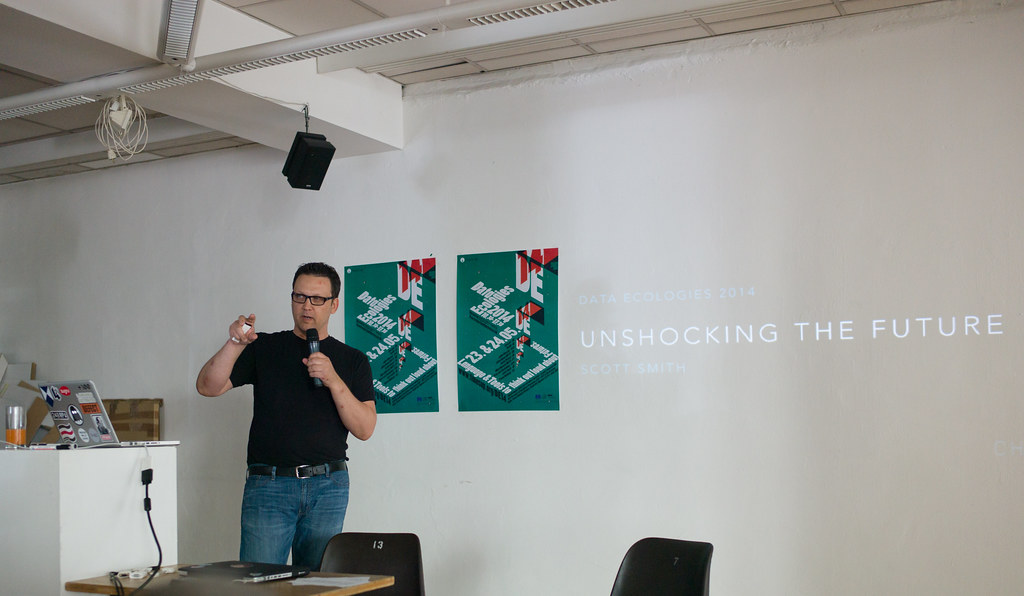
- Unshocking the future
- pragmatic perspective: having to solve problems in a concrete way
- how are the expectations set: people expect things to be strange, but the future of everyday life isn’t like that
- future shock orson wells
- everyday is slow and deliberate: “Tomorrow is today, just later” - things happen in small increments
- design fiction (Julian Bleeker, Bruce Sterling) - jumping over conceptual walls, give ideas into the hands not just minds of people (away from power point and reports in three hole binders
- speculative & critical design - new vocabulary into the futures field - a different experience to interrogate different futures
- tech companies pitching their 'flat-pack futures' in videos (as design fiction, but without any history) - speculative technology demos - again stretches expectations of people - without tangible, realistic experience - takes us further away from discussions about what the future might be like
- factionalisation - highly realistic worlds to explore the future - mash-up of different approaches, distorting the landscape
- IDEO: “made in the future” - something that could have been made in an RCI design interaction
- things are being put out there, but not helping how we talk about futures
- Nick Foster: “The future mundane” - why should futures be designed for the super heroes - why not for the unnamed characters, the extras or background talent - we need more 'randoms', more people off the street
- Tobias Revell: Monopoly of Legitimate Use - rethinking the aesthetic - situation present in our lives now: no dialogue, no artefacts - we can see ourselves there, identifying with the person
- things that are NOT extraordinary make the audience connect more
- “Corner Convenience” - Near Future Laboratory - things are slightly unfamiliar in a familiar setting, totally believable - short film
- “The Good Wife”, “Person of Interest” - legal drama, with little threads of strangeness - something slightly new
- futurist cone (probable, plausible, possible)- where do the different design fiction projects sit in terms of time and probability
- Steamfunk stood here: storystorm cityfictions at Future Everything -
- conversation about big data, embedding it in the everyday football culture - “Winning formula” (Scott and other secret football fans) in the national football museum; created a newspaper from the futures - central artefact from the daily sports culture; newspapers in the museum and in newspapers - how would people interact with something so familiar, but seeing that “something is not quite normal here”
- it had to feel and smell as the real thing - both the artefact and the stories - it is similar enough
- watching how people interact with the newspapers outside of the staged environment and watching their reaction - slipped into the news stands, giving it to people in its 'natural habitat', rewilding the artefact (in urine soaked telephone booth, walls… encountering it in the environment - finding your own speculation in a random spot in the city
- CCCB in Barcelona exhibition - The science of Big Data
- how do we use the nature of the artefact and experiences to get to people who don’t usually engage with such experiences
- near future lab researchers the reactions to the artefacts
- how do we begin to establish some levels without constraining artistic explorations to be able to tell one kind of work from another?
- examine a complex system
- going for subtleties, not extremities - slight deviations - keep the speed of change in mind
- providing an experiential on-ramp for the non-professional
- rely less on overt polemic and more on extrapolation - taking things gently forward
- seeks out entrenchment and have staying power as well as advancement
- calibrate uncanniness
- guide the audience toward a future
- “if it is too weird, it will be dismissed as art, and if too normal, it will be effortlessly assimilated” - Dunne & Raby
- getting people to talk to us about how they explored different pieces (both unknowingly and knowingly)
- different people reacted differently to it
- frustrating legal issues with using real people and companies in the stories when inserting the newspaper as an excerpt in the evening news - had to make imaginary people and things to allow this to happen
- all politics is design fiction - incrementally calibrating the message
- we need a vocabulary to have a better conversation
Peter von Stackelberg
- using transmedia storyworlds to shape the future
- we have to communicate better - we must tell stories about the future to shape the future
- emotion - element in human information processing - not just data
- moving from data to wisdom (data→information → knowledge → wisdom) - adding context (global, local, personal) and experience (univrsal, individual)
- storytelling can bring in context and experience to the data
- data & information-only reports don’t mean much to people
- transmedia storytelling is telling one or more related stories across two or more types of media
- Collapsus - transmedia story about the collapse of oil industries (2009)
- DOctor Who - transmedia property
- Future states - the US in the future
- Pine Point by the Goggles (Canada) - town disappeared after the mine closed - now a transmedia story reconstructed a history of the place: https://en.wikipedia.org/wiki/Welcome_to_Pine_Point
- How to talk about of the communities we will lose in the future, communities that will disappear under the ocean?
- transmedia project invite you to come through a door, but you’re not sure how to proceed and what lies beyond
- careful design is critical to effective transmedia stories (links, structure, worldbuilding)
- worldbuilding - creating a universe in which all your stories exist.
- Tolkien is a great worldbuilder (history, geography, languages…)
- Autobotica’s Volta: A brilliant discovery in a cloudy future
- “transmedia property” - a collection of stories?
Process of worldbuilding
- often begins with characters + expands outward from them
- first create the world, then create the stories - if rich enough, the stories emerge from it
- 3 key design tasks: narrative design (characters, plots…), audience engagement design (how do you get them involved in the story), user interaction design (how do you navigate the people through the different media & components, how do people find the different pieces)
- timelines are an effective tool for organising storyworlds - a lot of information in a visual form + real and fictional events - a hybrid fiction and non fiction world - it helps stories emerge
- Narrative design framework (each of these should in one sentence), provides a focus, or a spine of the storyworld: select genre, identify premise, identify controlling idea in the storyworld (e.g. our storyworld is destroyed because we failed to deal with with upcoming danger), identify designing principle (audience will confront consequences of failing to act), central conflict (who fights whom over that), set storyworld timeframes (look at characters and world that are dynamic, long timespans - this is a problem with scenario horizons - you start to lose a sense that you’re dealing with dynamic systems - you have to chart a timeline - you have to think about how things change over time, create events (actual, fictional, anticipated…), create characters (complex process) - the detail emerges from the storyworld - start with when were they born, when do they die + key events in a character’s life, create of significant objects (e.g. ring in the Lord of the Rings), create the settings
- Audience engagement design: identify desired audience action - what do you want them to do?, identify audience gratification? what does the audience want?, Identify messages, define “message function/effect matrix” (function: acquire, trigger, alter, reinforce, effect: cognitive, affective, physiological, belief, attitude, behaviour), determine audience agency (how much control over the story do they have?
- user interaction design: mobile devices (tablets, smart phones..): identify participation (social, location…), media platforms, entry points into storyworld, inter-story transfer points, identify calls-to-action
- the future is not a single point in time, but a long timespan - watch out in scenario building
- settings in the storyworld: topos (physics, geography, climate, infrastructure…), demos (people, inhabitants/sentient beings - social structures, hierarchy, political systems, culture, food, daily life…), chronos (official or unofficial history of the world - including myths)
- the Mars trilogy of Kim Stanley Robinson - a dynamic alive story
- key things - “how did we get from here to there?” “How do we get there from here?”
- transmedia challenge: friction - moving from one medium to another you lose audience etc. mobile devices & tables help with this a bit - more seamless
- putting a human face on climate change - providing meaning to maps and data about it
- transmedia stories don't have to be built in one time, but over longer periods of time (things could play out over several years, to different audiences)
- how to get different stakeholders involved (government, business…)?
- why do transmedia stories tend towards fantasy & sci-fi? early transmedia stories linked to movies
- why do we need all this structure, when we have ~100 years of different types of stories?
- is audience engagement invited or not? the decision needs to be conscious… how would you like our fans to participate?
- ARGs are part & parcel of transmedia storytelling
- user generated content: aesthetical, ethical and narrative elements, game engine decides - as a criticism to a classical narrative arc - difficult with a global audience… - get a team who understands all possible arcs
Eva Lenz
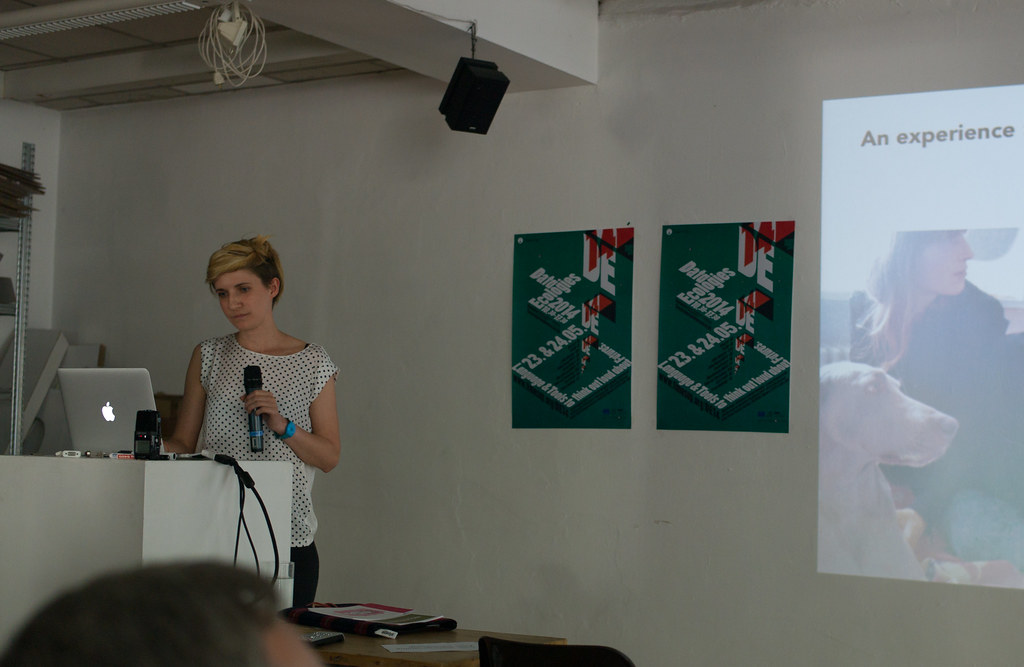
- Designing the intangible side of things - experience design approach to industrial design
- experience patterns - rules and phases “shared consumption” of a DJ event (anticipation phase, event, cooling-off phase: using a pattern like that and designing experiences = experience design - you tell people stories about what an experience needs to have a good experience - TV watching is not a good shared consumption experience
- experience design is not about technology that feels good, but about stories it endows people through its materials form - story itself needs to be designed: functionality and interaction become a part of the interaction
- it is not so much about the product, but about the experience of the product
- action theory levels to design a positive experiences:
- what (functionality, do-goals (Action - Goal)
- how - form and interaction, motor-goals (Operation - Condition)
- why (human needs & emotions, be-goals (Activity - Motives)
- Aesthetics of interaction connects the three levels (what, how, why) - relationship between the why & the how leads to meaningful experiences
- Why level: needs approach (needs theory in psychology: e.g. Maslow Self actualisation theory…); how level: interaction vocabulary
- set of 7 needs: need for competence (I’m good in what I do); relatedness (i feel close to the people I care about); popularity (I have an impact on what others do), Stimulation (I experience new activities), security (being safe from threats and uncertainties), Meaning (I’m becoming who I really am), Autonomy (I could do whatever I wanted)
- Need cards - tool for experience design (designed by Eva & Co)
- needs can be used as guides in experience design - don’t think about a product’s category, but instead you think of the experience (e.g. a relatedness experience) - then think of how the experience would materialise and what functionality would support it - functionality is guided by a particular need
- Needs as inspirational starting points (“Coffee shaker”) - map a need to the goal (popularity to making a cup of coffee)
- Interaction vocabulary - list of attributes to describe interaction - technology and modality free an inspiring instead of judgmental - tools for designers (like an ingredient list - slow vs fast, stepwise vs fluent, instant vs delayed…)
- study in the relationship between interaction attributes and the experience
- tool - cards for design decisions (interaction attributes and potential design experiences are mentioned)
- responsibility for designers - not just visual aesthetics, but also aesthetics for interaction
- tools used in research departments, in early stages of product development
- need to make a shift from having technology as a starting point to needs and experiences as the beginning
MITI
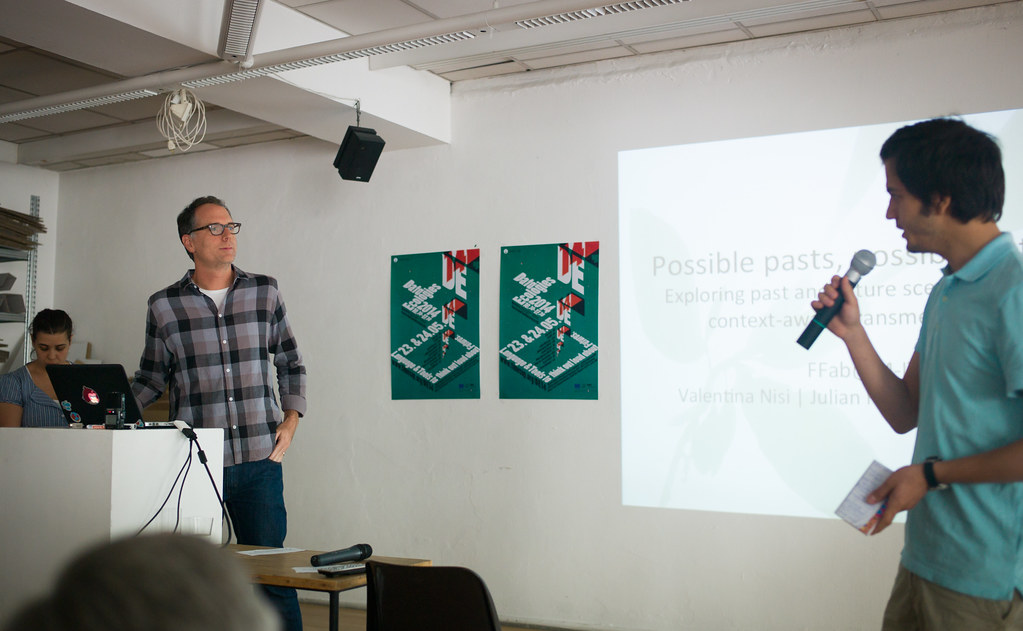
Transmedia storytelling (to type up from notebook…) and http://wiki.physicalnarration.org/wiki/index.php/DE14MaraDionisioJulianHanna
FoAM
Trevor Haldenby
- Mission Business: interdisciplinary: theatre, games, futurist, play theorist. now moving to become experiential futures consultancy - not so much for mass audiences
- design experiences to bring futures to life for audiences who want to explore, interact…
- digital / transmedia storytelling & strategic foresight
- strategic foresight at OCADU - embedded in the oldest of arts and design institutions in Canada
- i hear and i forget (written scenarios), i see and i remember, i do and i understand - confucius
- Rafael Popper - how are foresight methods selected (2008)
- Science fiction prototyping Brian David Johnson
- at the core of every written scenario: a story - great technological tools
- take a focus on experience design
- nathan shedroff CCA MBA program - experience (triggers, significance, duration…)
- experiential futures: what might it feel like to live and work in the future?
- transmedia storytelling - encountering stories as experiences
- Henry Jenkins: 7 rules what defines in to a good transmedia story (distilled to 3), applies to scenarios
- building a story world
- spreading the story across media ecologies
- engage audiences and participants as creators and curators not just clients
- high tension crisis mode decisionmaking
- didn’t manage to do a large scale ethnographic research about how people experienced the project - maxed out schedules
- big nut to crack: how to integrate ethnographic engagement with the audience - in the narrative and metanarrative level - harvesting information about the process
- ZED.TO ByoLogyc, Visitations, Shadowfall - ARGs, interactive theatre, pervasive event for a corporate client
ZED.TO: ByoLogyc
- simulation of the end of the world, lifestyle biotech, what would a ByoLogyc company feel like to interact with (“personal lifestyle enhancement solutions”)
- futures driven by people involved
- involving actors from improv (comedy) and military simulations
- synthetic pandemic: immune deficiency disaster
- 4 major live interactive performances - 4 archetypal futures
- 4 tracks / paths through the story - adventure (evacuee), power (paramilitary), action (resistance), priviledge (board member)
- online narrative - Versatile Intern Program for sharing their medical history
- graphic novel in e-ink (backstory)
- videos: vimeo.com/byologyc
- byologyc.com
- apps for facebook and twitter - simulate spread of disease through social networks
- funded through indiegogo, awards…
- becomes interesting when it began involving the movers and shakers in the synthetic biology world (e.g. pink army cooperative)
- most interesting resulting collab. with Synbiota - open source synthetic biology storytelling + strategy
- bringing the future to life: http://goog.gl/ChRDZU
Autodesk ByoLogyc Shadowfall
- extension of the storyworld for nasa, tech pioneers and venture capitalists
- how a company might oversimplify decisions with biotech, strong AI, asteroid mining, exobiology
- is there a benefit to keeping forecasting as boring as possible - corporate clients don’t want to make artefacts and results publicly available - worrysome related to ethics and agency
- interesting to create a shared storyworld made up of all the stories in a database - corporate clients don’t necessarily want this to happen
Julian Bleecker
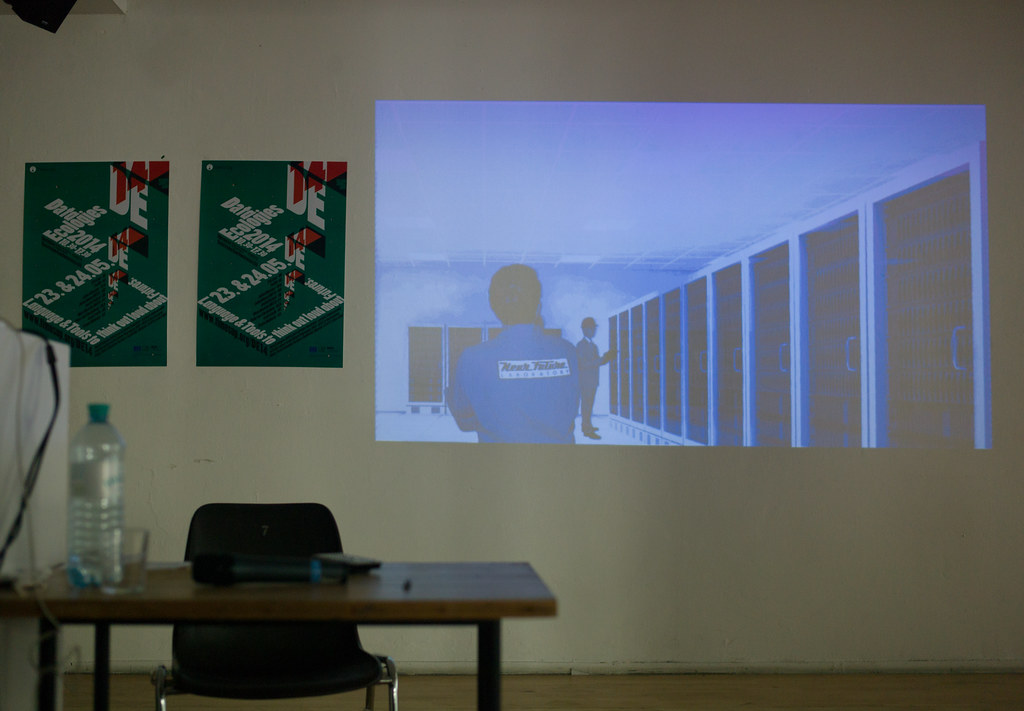
Video of the current works at the Near Futures lab: “A Catalog Of An Extraordinary Future When It Becomes An Ordinary Today”
- “Normal Everyday Futures”
- Opening your eyes to the world around you - everything becomes an opportunity to interrogated
(NOTE by the note taker: i expected to insert a link to the video that was played, as Julian couldn't make it, but it seems the link is private… I'm afraid I didn't take any notes while the video was playing…)
Justin Pickard

- “in sync?”, work in progress
- futures field - pretence of objectivity, expertise, de-politicised…
- you won’t change foresight… great deal of ambivalence, not all futurists are like this
- 'futurist as a label' - how do you orient yourself in the futures space
- problematic - neutrality, view from nowhere, or view from above
- “gods eye view, the arc” to gods eyes views - meddling helenic gods - rationality + playful/chaotic side of things (NOTE, could also be seen as related to Lila in Hinduism?
- google maps - no fixed borders - it depends where you’re looking from
- donna haraway - “situated knowledge”
- professionalisation of foresight - dangers of group think, compulsory passage points - a power of gatekeepers to the profession
- “professionalisation is killing art”
- specialists or generalists? tradeoffs - generalists need to work with people who complement your knowledge; specialists - injokes, inbreeding, no bridging points
- you have to become like a pufferfish - weird and spiky… - bruce sterling1)
- social, communal deal with uncertain futures
- sociology of expectation
- legacy of the futures that get out - “where is my jetpack” - persistence of 70s and 80s futures visions
- futures go through cycles and rear their heads again when you don’t expect
- cycles of technology development “Gartner Research” (May 2003), Moore’s law - simplification, but becomes socialised - the statement made real - self fulfilling prophecies by people ' who have the 'special knowledge' - performative statements that run out in the world and begin running amok
- performativity & performance (Judith Butler - gender studies) - utterances, actions have effects that you might not have expected
- wizzard of Oz
- legibility (James Scott: “Seeing like a State”)
- Danah Boyd “Social Stenography: learning to hide in plain sight (2010) - who are the audiences, who gets the meanings?
- strategy and tactics of revealing (game of Go - trying to surround the opponent) - foresight used to be about strategy, now how can it work as tactics
- where are all the travel agents gone? civil society comes up from the bottom up… the wilderness coming into the domestic space
- how do we currently deal with uncertainty? - through the lens of risk, boiling it down until it can be quantified in numbers - dangerous - mistaking what is unknown and unknowable for something we can deal as a probability
- liminal interstate that’s not market, nor state, but liminal, slightly illegal or vague
- doing nothing is very hard, you never know when you’re finished - maybe we don’t need to always take action
- divination, ritual, tarot, astrology - what have you not been looking at - making sense through patterns
- laboratory methods - bruno latour - chemical experiments to generate knowledge out of - uncertainty removed from the equation
- “masons, tricksters and cartographers” - a book on building cathedrals in the middle ages - learning by doing - taking sometimes over a century
- experiments enacting the laboratory - tuning infrastructure - lab is where experiments happen
- dan williams @iamdanw, stress testing, finding loopholes law-art-practice
- sarah @ablerism - researching signage and ramps in history
- superflux - consultancy and lab (business legible and more playful)
dealing with uncertainty
- juggad - tinkered together vehicle - it’s a solution to a problem using scarce means
- shanzai in china - solutions through piracy and stealing
- socialisation of uncertainty - our decisions make the world more uncertain for others
- hydra: what becomes stronger through attack - what is anti-fragile? you don’t want to be a hercules, you want to be a monster
- creativity in crisis? networks with a lot of redundancy
- superstruct, justing game master for the 'outlaw planet'
- synchronation of expectation - consensus grows bottom up
- if you give players the freedom and surrender control, you get interesting emergent characteristic
- jessica @jessginger - delphi party - getting everyone’s friends and family to get consensus
- iceland 0.5% of icelands’ population in one room - figuring out what it means to be icelandic? attempt to crowdsource the constitution - spiked… opening up the space for dialogue, changed the narrative…
- urban acupuncture - architecture should do small strategic interventions in public space, making energy flow better
- zine culture
- @gininnovation - discussing innovation with gin, interviewing people in spaces you like
- gonzo journalism
- disruption of conversations and narratives going in a particular direction
- James Scott “the law of anarchist calisthenics” - getting used to breaking laws - begin with jay-walking, reclaiming agency, getting comfortable lying to bots…
- be the change you want to see in the world - occupy, the way you live reflects the kind of future you want to live in the world - bootstrapping infrastructure - how do 'occupy' disaster recovery - tactical not strategic
- amplified teams - pooling energies and cooperating using software
- #quadrantconfusion (real-real, real-fake, fakereal, fake-fake)
- in what cultural context is it appropriate to lie? when are hoaxes ok, where are the edges?
- OEEA - earth as a system without borders - sending evil capitalists into space, they might come back hippy-ish
- unruliness - being weird at people - what is unacceptable
- The Bridge -eco-terrorist pathos…
- Roger Pielke “The honest broker” - making sense of science in policy and politics, but other hats are also available
- disasters can open up weird little autonomous spaces, solidarity, shared adversity - a platform on which we start building stuff
summaries, conclusions, digressions...

- towards electrolyte supplements for the booksprint
- entry points/rabbitholes and the ethics around disclosure and consent. advocate for compassionate methods
- from the 'suspension of disbelief' toward the 'active engagement of belief'
- expand on various methods to distil and surface discussions → harvesting (metaphor → as 'least unpleasant' or 'part of a cycle')
- weirdness and confusion (intermittent recurring themes)
- structure ↔ vagueness
- agile methods as potential
- x.ref 'exploratory forecast'
- ways of addressing processes at various scales. permaculture principles → multiplicity of techniques. fractal selfsimilarity or storyworlds
- references for writing on critical futures (cf. critical theory, richard slaughter and critical futures, integral futures) further references to relationship with futures and power
- constraints on practice (varieties of domain specificity)
- escaping the filter bubble → afrofutures, gulf futures, ASIS futures, etc+
- “futures and foresight is dissolving” time for sharpening tools may be over, seep into other relevant domains
- comparative value in refining methods or connecting to other domains?
- “socialisation of awareness”
- “walking backwards into the future” (c.f. Dougald Hine Promethean / Epimethean view )
- explore intrinsic sources of motivation rather than relying on extrinsic sources
- “old elements finding new homes”
Booksprint: summary of the seminar, extending discussions, distilling issues
Possible topics to expand in the booksprint: reaching out, the ethics of on-ramps, how to integrate people compassionately, ethnography of experiential futures, actively investing belief in an experience, surfacing stories that live in communities, lead ins and lead outs from a futures experience, weirdness, confusions, structure-vs-antistructure, preciseness vs vagueness, politicisation, literacy, education, impact on people in the long term, harvesting information as a part of a whole lifecycle of people’s engagement in futures, playfulness, enabling situations, call creating, disappointments when a future doesn’t happen, what happens as hope disappears, agility, future as a dynamic complex system rather than a point in time, iteration and adaptation, anti-fragility, exploratory forecasts, a wide range of futures to move away from dystopia, how to teach the processes and methods of futures thinking, issues of scale (permaculture principles, fractals, acupuncture, NNNI), ethics, critical theory of futures, consider positions of priviledge, dissolution and re-absorption of foresight, future of futures, socialisation of futures (of observation, awareness, filtering, synthesizing, storytelling and communication), how can we stitch together foresight and other practices, where you experiment the lab is, what is the motivation, historical perspective (walking backwards into the future), humour, different perspectives and modalities (and everything above)


